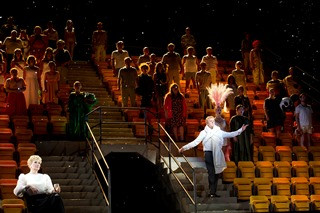|
Back
The Mad Emperor Buenos Aires
Teatro Colón
04/01/2014 - & April 4, 6*, 8, 2014
Detlev Glanert: Caligula
Peter Coleman-Wright (Caligula), Yvonne Howard (Caesonia), Martin Wölfel (Helicon), Héctor Guedes (Cherea), Jurgita Adamonyte (Scipio), Fernando Chalabe (Mucius), Victor Torres (Mereia/Lepidus), Martisú Pavón (Livia)
Orchestra of the Teatro Colón, Ira Levin (Conductor)
Benedict Andrews (Director), Ralph Myer (Scenic Design), Alice Babidge (Costume Design), John Clark (Lighting Design)

M. Wölfel (© Máximo Parpagnoli)
Premiered in Frankfurt in 2006, this was the premiere of Detlev Glanert’s Caligula in the Americas. The choice of a 21st century opera as the season opener is also a statement by the present administration of the venerable Teatro Colón. Later this season, more modernist works are presented. This is one of the world’s most prestigious and beautiful theatres. It has been one of the world’s leading theatres until the seventies when political and economic problems plagued Argentina. It is also one of the pillars of the identity of the portenos, the citizens of the port city of Buenos Aires. At several performances seen in the theatre, one could see parents taking their children to this repository of the collective memory as a rite of passage. Prices for prime seats are quite expensive, comparable to prices at the world’s top opera houses. The theatre is huge with a capacity of close to 2,500 seats and 1,000 standing spaces. Such a dichotomy leads to at least two publics, a conservative, well to do public and a fervent standing room and upper balconies public (el paraiso, or Paradise, given the vertiginous heights of the top balcony). Musically, both tend to be old fashioned, favoring 19th century works that evoke the golden years of the house, Verdi, Puccini and Wagner. Nonetheless, the public’s reaction to this modern work was on the whole positive.
Though tragic, the story of Caligula may not be the most operatic. The incestuous love interest, Caligula’s sister Drusilla, is dead at the opening of the opera. It is her death that pushes the young emperor into insanity. Based on the 1945 eponymous play by Albert Camus, it is more a narrative of a journey into insanity than a linear story. The music of Glanert, a student of Hans Werner Henze, is avowedly modern with a limited melodic line, except for the two leading high voices, the emperor's wife Caesonia, a soprano, and his freed slave, Helicon, a counter-tenor. Soprano Yvonne Howard portrayed an empathetic suffering wife delightfully. Dramatically, Caesonia was more a comforting mother figure than a spouse. Towards the end of the opera, she is convinced to let her husband kill her as a proof of her love. She impressed in the few passages that displayed a melodic line, making one regret she did not have more to sing. As Helicon, German counter-tenor Martin Wölfel had perhaps the only role with demanding high notes to sing. The contrast between his and Caesonia’s melodious music and the atonal music of the lower voices made for a dramatic effect. The title role is quite demanding as the emperor is on stage during almost the entire opera. Australian baritone, Peter Coleman-Wright, was an excellent Caligula, unhinged by the various modes of folly the tyrant displayed. He had immense charisma and a powerful voice. Vocally, his and most roles are parlando. Hence, it is not possible to judge them by the typical operatic parameters.
The sets, an amphitheatre which is more football stadium or corrida than Roman monument, were effective. Despite a splash of Roman tunics, the costumes were mostly contemporary, no doubt to stress the universality of tyranny and the corrupting effect of absolute power in our contemporary world. The drama was intense throughout the opera. At the beginning of the opera, Caligula sends his slave Helicon to search for the moon. Throughout the opera, he continues to ask Helicon for it. In the third act, Caligula decides to dress up as Venus and to celebrate his marriage to the moon, an event that does not augur well. Surprisingly, the music in this act is a hybrid of Philip Glass and Broadway. The emergence of quasi-melodies helped prepare one for a climax, the tyrant’s assassination by his Senators. Equally effective was the emergence of Caligula from underneath his assassins as a reminder of the durability of tyranny and of the ever-present power of madness.
Ossama el Naggar
|